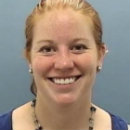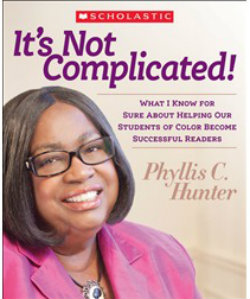Helping Our Students of Color Become Successful Readers
It’s Not Complicated: What I Know For Sure About Helping Our Students of Color Become Successful Readers
By Phyllis C. Hunter
(Scholastic, 2012 – Learn more)

I’ve always been inspired by the students that I have worked with to make a goal of closing the achievement gap, especially for students of color. Reading about strategies that would work to help students of color become successful readers made perfect sense to me.
Upon reading about Phyllis C. Hunter’s credentials, including her working with President Bush for NCLB, I thought there had to be some groundbreaking ideas within the book. Unfortunately, there weren’t. The majority of the book was about how to give students access to books. However, despite its lack of fresh insights, I did find the book inspirational.

Throughout the book there are options for other resources on the topic, which is helpful, but at the same time feels slightly pushy. A majority of the resources and ideas are rooted in the publisher’s products (Scholastic).
The introduction of each chapter includes experiences from the author as well as others that relate to the topic of the chapter. This helped me relate to the concept provided and made me want to read more about the chapter.
A charge to change the world
Phyllis C. Hunter states that the purpose of the book is “to feel an electric charge of urgency”; I felt that charge just reading the first chapter and the statistics that she presented within those pages. The book did make me want to go out and change the world and help those students become better readers.
The information of each chapter is highlighted below.
#1 Students Need Support to Become Readers
Hunter points out that we assume that all students of color are failing which isn’t the case, but that some students of color are. In order to stop the trend, we need to make some changes and support all students for reading.
#2 Motivated, Reading Can Change Their Lives
I like how she says to recognize that the time used on the internet and social media are opportunities for reading and writing. Since it’s become such a larger part of students’ lives, we have to accept that and use that to our advantage. We can motivate them by who they are reading about as well as what they are doing to become better readers, especially meeting their need to learn more words. Hunter uses many current concepts throughout this chapter, referencing The Blind Side and Freedom Writers. She suggests providing children with books on their independent reading level, not necessarily on grade level, especially for reading-resistant readers.
#3 Access to More Books
The focus of this chapter is to have a plethora of books within classroom libraries, not just outside libraries. Scholastic recommends 1,000 books in a classroom library, which seems overwhelming, but strategies for upgrading your classroom library were included. The major theme throughout this chapter is that the “key to equality is access.”
#4 Around the Clock Oral Language
This concept is self-explanatory. We need to get parents involved as well as provide students with oral language at all times during the day.
#5 Avid Reading
The focus in this chapter is on the importance of vocabulary development, not only on the teaching strategies provided by teachers, but on students’ increased reading which will lead to 3,000+ word exposure each year.
#6 K-3 grades
The introduction of this chapter is about an experience with a child who couldn’t read in 3rd grade and didn’t like the baby books. In my experience this is very true. Students don’t want to be caught dead with easy books and instead don’t read. The chapter focuses on effective early reading classroom strategies and the importance of interactive read-aloud (to show how much you love reading). The author provides a tip to principals to bring a book to read into the classroom when coming to visit; I love that idea. The author also suggests having reading logs that include everything, even text messages, to show the importance of reading in daily activities.
#7 Not Reading if Not Comprehending
This chapter provides a comprehension lesson plan, which will be helpful for some students.
#8 RTI
This chapter focuses on the different tiers (Response to Intervention) and what can be done at each tier. I think this section could be more in-depth and offer further suggestions for those who are having difficulty teaching struggling readers. There is a lot of evidence within the chapter of the importance of reading for black children, but not much focus on actually utilizing RTI.
#9 Nonfiction
This chapter includes the importance of getting boys especially to read nonfiction since they are typically interested in hobbies and sports; it includes a good nonfiction reading strategy list. The main idea of the chapter is to let the students read what they are interested in reading about.
#10 Supporting Families of Color
The focus of this chapter is to get everyone that interacts with the student involved in the reading process. I like the author’s ideas to make parents feel welcome.
#11 Kids Using Data
This chapter is aimed at helping students understand what the data about them means.
#12 Help All Kids of Color Believe They Will Go to College
The focus for this chapter is about how critical reading is for increasing proficiency and test scores and making it into college.
Overall the book provided important information and is a helpful tool for those who are interested in exploring more resources (since there are many book resources mentioned within the text) as well as motivating or renewing teachers’ motivation to inspire all readers, specifically readers of color.
Maribeth Wicoff is a former Philadelphia special education teacher, where she taught for 6 years. Maribeth was a Philadelphia Teaching Fellow and earned her Masters in Education from Chestnut Hill College. She is currently pursuing a PhD in School Psychology at East Carolina University in order to continue to help all students succeed.


































